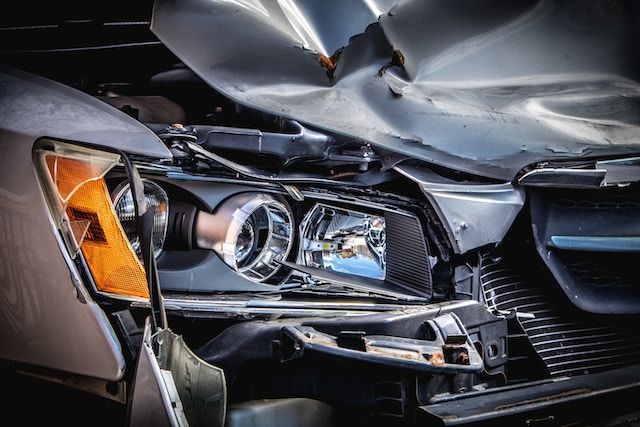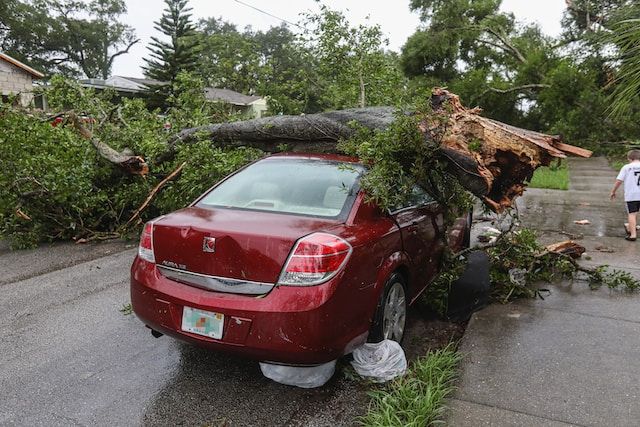How to Get Cheaper Car Insurance
We've collected millions of car insurance quotes to help you find the cheapest insurance available. This data — much richer than anecdotal experience or conventional wisdom — informs our opinions about buying insurance in a way no other website can.
In some states we have additional tips on getting cheaper car insurance. See a detailed chart and price comparison for your car insurance by clicking your state below. Or keep reading to learn how to save on car insurance anywhere.
What are you paying for when you buy insurance?
Most of what you are paying for with insurance is the privilege of having someone with deeper pockets pay for the damages caused by you or to you when something goes wrong — like an automobile accident or a tree falling on your car when it’s parked in your driveway.

Photo by Clark Van Der Beken

Photo by Mick Haupt
You can’t negotiate rates with the insurance company because prices aren’t flexible. There are some things you can do to lower your premiums in general, but for the most part, the only two meaningful levers you have when buying car insurance are choosing your coverage and choosing your deductible. To some extent you can also choose what is covered.
Your coverage limit is how much the insurance company will pay when you have a claim. Your deductible is how much you will pay BEFORE the insurance company pays anything against that claim.
See how different coverage amounts affect your premium and how different deductibles do, too.
Standard car insurance coverage types - Bodily injury liability coverage . This coverage applies when someone else is injured while you or anyone else is driving your car.
- Property damage liability coverage . This covers damage to someone else’s car (or other property) when you cause a crash.
- Minimum liability insurance . Some people and states describe the whole package of insurance you need for bodily injury and property damage liability coverage this way. It’s not a separate kind of coverage.
- Collision coverage . This covers damage to your car from a collision.
- Comprehensive coverage . This covers damage to your car from non-collision events.. Examples include: a tree falling on your car, hitting an animal, someone smashing your headlights, theft, or if your car catches fire.
- Uninsured and Underinsured Motorist coverage . This kind of coverage helps you out when someone else causes a crash and they don’t have enough insurance to cover the damages and injuries that you suffer. Your insurance will pay you to repair the damage or cover your injuries, even though the person who caused the accident can’t.
Think this isn’t a problem to worry about? The Insurance Information Institute says nearly one in eight drivers is uninsured, but it varies wildly by state. Be sure to read their estimate for uninsured drivers in your state when considering this add-on.
- Personal Injury Protection (PIP) . PIP covers things other than the vehicles themselves – it can cover medical bills, rehabilitation, physical therapy, lost wages, funeral cost, and other “essential services” like childcare while you’re at physio. It applies to you as the policyholder, not to the other people involved in the accident and it does not include property damage.
Most people who think about PIP live in a “no fault” state. “At fault” vs “No Fault” is a fairly complex topic. PIP is something to consider if you live in one of these states: AR, DE, DC, FL, HI, KS, KY, MA, MD, MI, MN, NJ, NY, ND, OR, PA, SD, TX, UT, VA, and WA.
How to make your car insurance cheaper
There are thousands of factors that determine how much your insurance costs, and everybody’s situation is somewhat unique. The basic influences are: your driving record, the cost of repairing or replacing your car, how much coverage you choose, and what you pay for your deductible. 
Photo by Dan Cristian Pădureț
You only have control over some of these details when you shop for insurance, so it’s a good idea to learn which ones and how to lower your car insurance premiums.
How do my coverage choices impact my premium?
Theoretically the amount of coverage you choose should be the single most important factor in determining your car insurance premium as it is literally what you’re paying for — the coverage.
It is true that the more coverage we elect, the more our premiums will cost. A little known fact is that premiums cost a lot more when you jump from minimum coverage to middling coverage, but do they jump a lot more when you elect great, asset-protection coverage? Let’s find out.
In Texas, drivers with cars valued between $35k and 45k, with the legal minimum coverage for bodily injury ($60k for all injured parties per accident) and $25k for property damage per accident, pay an average of $91 per month.
Increase the coverage to $100k for total bodily injury coverage per accident and the premium goes up to $139 per month. That’s a 53% increase in premiums for a 66% increase in coverage — not too bad, especially since $100k will cover most accidents fully.
What if we increase the coverage another 3x to $300k? The average premium only goes up 7%! That’s because there are many fewer accidents that cause between $100k-300k in bodily injury (thank goodness).
Imagine how life changing that $200k would be if you had to pay it out of pocket… You might have to sell your house or empty your retirement savings. That seems like a great deal for peace of mind if something huge goes wrong.
Find out what the right amount of coverage is for your personal situation with Coverage Cat.
Will a higher deductible lower my premium?
Although a higher deductible ought to make your premium decrease, it doesn’t always work that way in practice.
For example, using Coverage Cat’s experience observing millions of auto quotes, cars valued between $35k and $45k in Texas have an average monthly premium of $218 with a $500 deductible and a $131 premium with a $750 deductible. By increasing the deductible by just $250, the average driver saves $87 a month — this pays for itself in three months!
Here’s where it gets even weirder… If we raise the deductible to $1000, we expect the premium to go down further, right? Nope! The average premium kicks back up to $190 per month! Prices in insurance don’t always make sense.
Now if you didn’t have all this data like we do at Coverage Cat, how could you possibly know which deductible was going to save you the most money?
Let us help you optimize your car insurance .
Other ways to lower your premium
There are a lot of factors which go into your car insurance premium. That doesn’t mean you need to pay attention to all of them. Here are a few factors where you can move the needle. - Find the sweet spot for your deductible
- Ask your insurer about every available discount — you’d be surprised how many there are!
- Make sure you’re not paying for extras you don’t need, like rental car coverage or tow coverage if you have roadside assistance from another source or pet coverage if you don’t have a pet
- Be a good driver (you may need to wait for bad driving events like tickets or crashes to roll off your records, but it could save you 20% or more)
- Improve your credit score: many states use your credit score to predict what kind of driver you are (and charge accordingly)
- Don’t buy a new car: cars that are at least three years old are 20% cheaper to insure
- Drive less: some insurers offer discounts related to reduced mileage
- Choose the right coverage limits appropriate for your net worth
Is cheaper insurance actually better?
Sometimes in life cheaper is better — if you don’t care about how long an item might last because you’re only using it for a short time anyway, or you don’t care if that tomato was grown organically, or that adorable dog from the pound only cost $75 instead of thousands for the pedigreed version from a breeder.
Other times, cheaper is not better. We’d argue car insurance is probably not the optimal place to cheap out. If you don’t have any expensive assets — you drive an inexpensive car and you don’t own a home — you probably don’t need “full coverage” insurance ( that doesn’t exist by the way ).
There are plenty of situations where you might want more than the basic minimum required by law. Here are two surprisingly common ones: - If you’re leasing or financing a car, your lender might require you to have more than the minimum insurance because they want optimal protection for the asset they own. You might even want gap insurance which covers the difference of what the car is worth vs what you still owe.
- If you have appreciable assets: you own a home, you bought a shiny new Benz, or you have a business that isn’t incorporated.
At the end of the day, when you get in an accident that costs more than your insurance policy pays out, you pay the difference. If your bodily injury damages are way higher than your policy limit — not hard to imagine with healthcare costs being what they are — the other party can sue you for all you’re worth.
Rather than try to figure out the secret sauce yourself, let Coverage Cat do all the legwork for you. We’ll find your perfect insurance , and we’ll tell you what it is whether we can sell it to you or not.
How to save time when shopping for cheap car insurance
The bottom line is that only your final quote really matters, not all of the specific factors which contribute to it. 1. Don’t read every article about what every insurance company charges every type of driver. You won’t optimize your own car insurance cost this way. 2. Don’t fret about factors you can’t control. 3. Get multiple quotes. Even (especially) from companies you’re not familiar with. 4. Use Coverage Cat — we do all the work for you. One questionnaire, personally optimized insurance, and you’re done. We send you an email with our best policy recommendations across multiple insurance companies. You are not locked into the policy we recommend and we can modify it after we’ve generated your quote.
When to shop for cheaper car insurance
One of the most little known facts about car insurance is that you are not stuck with it for a whole year after you enroll in a new policy. You should recheck your car insurance rates every year, but there are other times to consider shopping around, too. - You're no longer considered a good driver
- It has been 3 years since your last moving violation or accident
- The car you bought new turns 3 years old
- You're moving — even just to a new zip code could make a big difference in your rates
- Your teenager is about to start driving
- You’ve turned 26, 30, or 65 (or, at any age, you’re a relatively new driver and have made it a few years without incident)
- When you get married
- When you start sharing a car with a significant other (adding new people to policies changes the premium)
- In some cases, when you have a baby. Some insurers think you’re likely to drive more safely with a baby on board, but most don’t think this is a reason to drop your premiums.

Want to find the best insurance? Need help?
Coverage Cat shops for you. We search across dozens of major insurers and use data science to compare millions of real quotes. The result? The best combination of policies, coverage, and price for your personal financial situation.
Our promise:
- We only share your information to get you quotes
- No unsolicited calls from us or other insurance agents
- As few emails as needed to find you the best insurance


